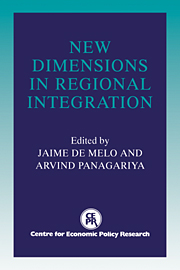Book contents
- Frontmatter
- Contents
- List of figures
- List of tables
- Preface
- Foreword
- Acknowledgements
- List of conference participants
- PART ONE SYSTEMIC ISSUES
- PART TWO COUNTRY ISSUES
- 6 The new regionalism: a country perspective
- Discussion
- 7 The European Community: a case of successful integration?
- Discussion
- 8 Regional integration in Sub-Saharan Africa: past experience and future prospects
- Discussion
- 9 Latin America's integration and the multilateral trading system
- Discussion
- 10 Regional integration in Eastern Europe: prospects for integration within the region and with the European Community
- Discussion
- 11 Regional trade arrangements in North America: CUSTA and NAFTA
- Discussion
- 12 Trading blocs and East Asia
- Discussion
- 13 Prospects for regional integration in the Middle East
- Discussion
- Round Table Discussion
- Index
Discussion
Published online by Cambridge University Press: 04 May 2010
- Frontmatter
- Contents
- List of figures
- List of tables
- Preface
- Foreword
- Acknowledgements
- List of conference participants
- PART ONE SYSTEMIC ISSUES
- PART TWO COUNTRY ISSUES
- 6 The new regionalism: a country perspective
- Discussion
- 7 The European Community: a case of successful integration?
- Discussion
- 8 Regional integration in Sub-Saharan Africa: past experience and future prospects
- Discussion
- 9 Latin America's integration and the multilateral trading system
- Discussion
- 10 Regional integration in Eastern Europe: prospects for integration within the region and with the European Community
- Discussion
- 11 Regional trade arrangements in North America: CUSTA and NAFTA
- Discussion
- 12 Trading blocs and East Asia
- Discussion
- 13 Prospects for regional integration in the Middle East
- Discussion
- Round Table Discussion
- Index
Summary
Saxonhouse in Chapter 12 examines the economic forces which drive the East Asian economies toward or against the formation of a regional trading bloc. He applies new methodologies to analyse the trade patterns and practices of East Asian market economies (including the ASEAN nations) to ask how economically integrated the region is, whether there are biases within the region beyond the normal economic complementarities of factor endowments and distance which push these economies toward formation of a regional bloc, and implicitly what would be the optimal form of trade arrangements. The bottom line is that the East Asian economies benefit far more from an open global, multilateral trading system than they do from one in which the world is divided into two or three major regional blocs.
Section 1 presents a theoretical model which shows that forming a trade bloc can benefit its members while reducing world GNP, by changing the terms of trade against the unorganised non-members. However, as membership expands, the incremental GNP gain is at some point offset by a reduction in the terms of trade effect, so the bloc is unwilling to take in new members. For the East Asian economies the policy implications of this plausible model are clear: join the newly-forming North American Free-Trade Agreement (NAFTA), or fight it by forming their own bloc.
The most innovative and important part of the chapter is the development and testing of a bilateral trade model to determine whether the existing trade patterns among the East Asian market economies are due essentially to factor endowments and distance (transportation costs), or are driven in addition by some non-economic regional bias.
- Type
- Chapter
- Information
- New Dimensions in Regional Integration , pp. 416 - 422Publisher: Cambridge University PressPrint publication year: 1993



